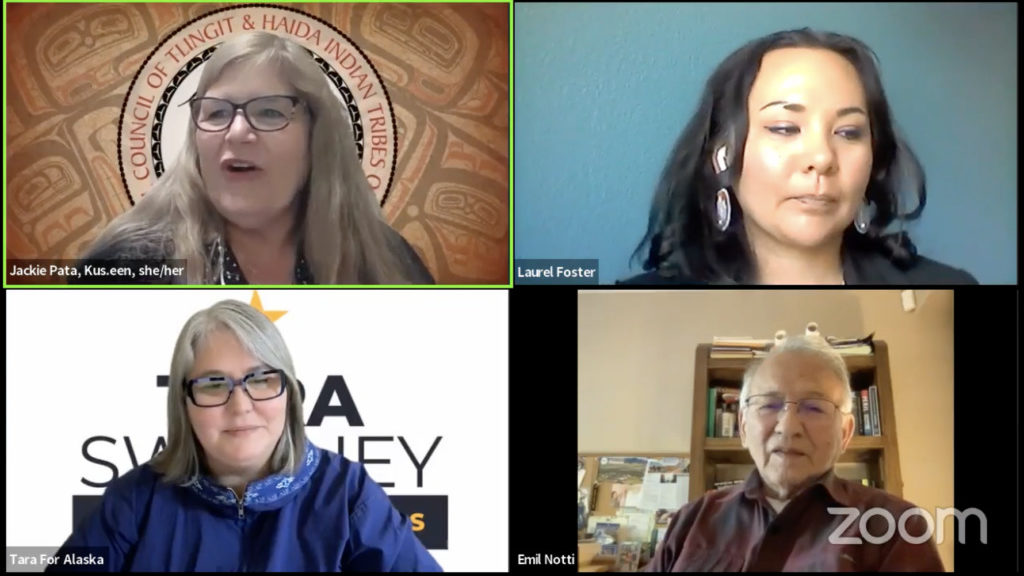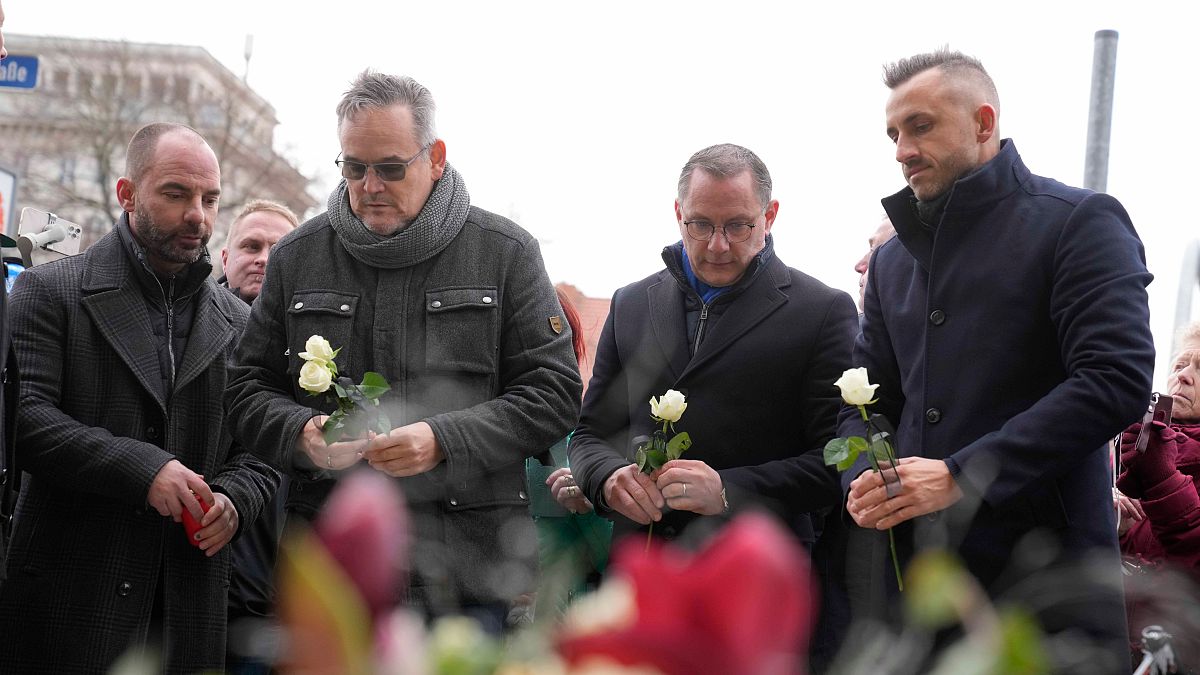Alaska
Alaska Native vision for the future: Self determination • Alaska Beacon
ANCHORAGE, Alaska — Indigenous leaders want a seat at the table and to be seen and heard. “Nothing about us without us.”
That’s the message Indigenous leaders shared at an Arctic symposium that organizers say brought in participants from 30 countries. Six Inupiaq, Tlingit and Athabascan leaders kicked off “Arctic Encounter 2024” with a plenary session entitled “Northern Indigenous Leadership: Our Future, Our Vision for Success.” Organizers say the three-day symposium drew about a thousand leaders in diplomacy, research, science, the military and business to the Dena’ina Convention Center in Anchorage.
Kasannaaluk Marie Greene, Inupiaq, is president of the Inuit Circumpolar Council, which is made up of members from Greenland, Canada, Russia and the United States. She told an audience of about 150 people her goal is to continue to fulfill the vision of the council’s founder, Eben Hopson, Inupiaq: “to have our Inupiat people at the international level come together to strengthen our unity, to work together in harmony as we come together and address our concerns, our common concerns, our challenges, and what we need to be doing going forward as we continue to build that unity.”
Greene said Hopson expressed at the founding meeting of ICC in 1977 “the need to … to be promoting our language, our culture, our customers, who we are as Inuit and to promote and work with our governments, to ensure that we have the policies, long-term policies in place and to also address our interests at the international level.”
She added that Hopson challenged “us to do what we can to protect our homeland, to protect the Arctic and that’s a privilege being in this role that I have.”
She said communications need to be honest and respectful toward governments, but “we have got to be expressing our concerns about the change of the climate that we’re now experiencing in the Arctic.”
Apagzuk Roy Agloinga, Inupiaq, is president and CEO of the First Alaskans Institute, an Alaska Native policy and advocacy nonprofit. “(Our) people have always lived in this land,” he said. “We have a passionate and deep connection to every place. And the fact that we are able to make decisions about education, about the economy, about any kind of policy that impacts us, is really critical.”
Agloinga said the institute plans to build on the training and education previous First Alaskans leaders have provided on the importance of subsistence, an effort he said that helped lead to the appointment of three subsistence users to the federal Subsistence Board. “One of the things that we’ve done, of course, is a lot of advocacy around protecting our ways of life and have such an amazing working group with about 200 people who are from across the state.” That work was brought to the forefront, he said, “so that we can really work closely with our communities to identify ways so that they can continue protecting subsistence… that will always continue to be a major priority for us, and we want to make sure that our community understands what the issues are and how to move forward.”
Agloinga said youth leadership is also a key area for the Institute. “Our youth are pretty amazing and the youth that participated in (our) Elders and Youth conference really already show tremendous leadership in their region. We want to make sure that those young people are able to get as much support as they can, as much education as they can, as much knowledge as they can about the issues that are so important to us as Native people in Alaska so that they can continue the fight for self-determination and really understand what that means.”
Aaron Schutt, Koyukon Athabascan, is CEO of the Alaska Native regional corporation Doyon Limited. He told the audience the Doyon region is about the size of the country of France, and home to about 40 communities, and 25 village corporations. Doyon has about 20,500 shareholders.
“We were able to select and retain about 12.2 million acres within our very large homeland,” Schutt said. “We share about 4 million of those acres with our village corporations where they own the surface and we own the subsurface and we have about 8.2 million acres that we own outright like all the other Native companies. Our job is to make money, train and employ our shareholders, and then, most importantly, steward our land base. 
“We have our land. We have our people. We have to have economic success in order for our people to thrive, in order for us to steward the land. The federal government doesn’t give us any money…We have trespass, fire, gravel, wildlife, all these issues that are very important to our people, that we have economic success in order to take on all of those issues.” He quoted a former chief who would often say, “We’re doing well; we can do better.”
Dr. Pearl Kiyawn Nageak Brower, Inupiaq, is president/CEO of the Ukpeagvik Inupiat Corporation, and Affiliate Research Professor at the International Arctic Research Center. She said like the other village, urban and regional corporations created under the Alaska Native Claims Settlement Act of 1971, Ukpeagvik Inupiat Corp represents a distinct Alaska Native community village tribe. ”But each has an important land base and each has had to learn how to traverse the for-profit environment.”
The Ukpeagvik corporation has about 3,800 shareholders and stewards about 229,000 acres of ancestral lands. “We employ about 4,700 people and about a quarter of those are here in Alaska,” Brower said. “We are the ninth largest company by revenue in the state and we’re hoping to be the eighth after the end of this year. So our mission is really we bring our Inupiaq values to the services and products that we provide to enhance the lives of our shareholders.”
She said of shareholders, “They’re us. They’re our aunts and our uncles, they’re our grandparents, they’re our parents, they’re our children, our grandchildren, and what that looks like into the future. I think we also have challenges in the market and in policy. Nothing about us without us is just how we have to move forward.”
Brower added, “I think as Indigenous people, right, we are the best ecologists. We are the best scientists for our region. We are tethered to our place. We care about our land. We want it to be there for future generations…listen to the people, listen to those who have lived off this land and learned the stories and heard the stories and been taught about this place for generations.
Morrie Lemen, Jr., Tlingit, is executive director of the federally recognized tribe, the Inupiat Community of the Arctic Slope. He said the Alaska Native Claims Settlement Act was a dramatically different approach to federal Indian policy. “It created a fragmented system of the Alaska Native representation and delivery of services that required a coordinated approach to effectively serve Alaska Native people. It also resulted in landless groups, which ICAS is one of.”
Speaking of his vision of success, he said “The first thing that comes to my mind is self-determination. We determine our future by building our own, growing our own leaders based on millennia of tradition. Listen to us. I challenge the audience every time you think about the Arctic, think about the people first. What we have identified as our needs, not what you think we need. The North Slope approach to leadership is centered at the local level. There’s a trust that the residents of our villages know what is best for their village and we support them, not supplant them. At ICAS, we work to uplift, empower, and grow the tribes and our tribal citizens within our region.”
Tara Katuk Mac Lean Sweeney, Inupiaq, is vice president for external affairs, at ConocoPhillips Alaska, an oil company that has had a presence in Alaska she said for 50 years, “and we continue in our commitment to the state.”
She said life has changed in Alaska over the years. “I grew up on the cusp of development and was 16 when we finally had the infrastructure to have a flush toilet in our home. And there are many communities throughout Alaska that still don’t have the infrastructure to afford that luxury, and it’s important to remember. But what development has provided to Indigenous communities across the North Slope is opportunity, opportunity for education, opportunity to live in thriving communities that have police and fire protection, opportunities for work and career, career advancement. 
“So our goal and our focus at ConocoPhillips really is to develop Alaska resources safely and responsibly and responsibly really means a number of things: Effective stakeholder engagement. It also means transparency and respect in the process. But effective stakeholder engagement means that local voices have a seat at the table, that they help guide the process, the projects through the conception phase all the way to the production phase. And so for me, when you ask me what success looks like, that would be my answer.”
The three-day conference continued with sessions ranging from energy, governance, and wildfire management, to oil spill response, security, and waste management, as well as media, leadership, thawing permafrost, food security, science, education, health, shipping, and geopolitics.
CT originally published this article. ICT is an an independent, nonprofit, multimedia news enterprise. ICT covers Indigenous peoples.

Alaska
Hydroponics provide year-round growing for Alaska farmers

On a recent December afternoon, Soldotna farmer Taylor Lewis preps for a day of harvesting crops. She walks to a tray filled with ripe lettuce and snips a head of it by the stem.
It’s just one of about 900 plants that Taylor and her mother-in-law Jayme Lewis will harvest and process this week – despite freezing temperatures and slushy snow outside. That’s because the duo works for Edgy Veggie, an indoor farm that grows produce year round.
“In the summer, a lot of our business drops off because folks are gardening at home. But in the winter, they’re not, because it costs money to heat your greenhouse,” Jayme said. “It costs a lot of money to heat your greenhouse.”
The company is a hydroponic farm, meaning they grow plants without soil. Hydroponic systems recycle and reuse nutrient-filled water, which minimizes waste. Specially made lighting and climate controlled conditions make it possible for Edgy Veggie to grow indoors during the winter months.
Around Thanksgiving, the company harvested 150 pounds of lettuce, enough to make about 800 salads. That took two days and was one of their biggest hauls of the year. Although not a typical harvest for the company, Jayme says she does see an uptick in business during the winter when Alaska’s produce is almost exclusively shipped up from the Lower 48.
“If you go to the grocery store and pick up a head of lettuce right now, by the time you get it home it will be wilted,” Jayme said. “That’s sad. Literally, that’s sad.”
Jayme says some local restaurants have sourced their vegetables from Edgy Veggie because they last longer and are fresher than grocery store produce.
Nestled between two train cars-turned-restaurants on the other side of town, Henry Krull walks inside his shipping container farm. He points to a wall that’s growing hundreds of bunches of butter lettuce.
Krull is the owner of fresh365, another Kenai Peninsula based hydroponic farm. Just like Edgy Veggie, the farm operates entirely indoors.
“The advantage of growing indoors, in a container like we have, is that we can control the environment,” Krull said. “We can grow no matter what’s going on outside. It can be 30 below outside, but it’s always 70 degrees or so inside.”
fresh365 also sees an uptick in direct-to-consumer sales in the winter. Otherwise, most of their sales go to other businesses, like local restaurants.

And while indoor farming means fresh, local produce year-round for Alaskans, it faces a number of challenges. Krull says growing in a hydroponic setting is much more expensive than traditional farming methods. So, to offset his farm’s energy costs, he installed solar panels, which were partially funded by the U.S. Department of Agriculture’s Rural Energy for America Program, or REAP.
But, Krull says the property doesn’t get much sunlight in the winter.
“The sun is a very valuable commodity, it’s valuable for not only producing electricity, but it helps to lower the energy costs,” he said. “And the energy costs of the farm containers we have is actually very, very high, because we can’t take advantage of the sun.”
Edgy Veggie, on the other hand, doesn’t even have solar panels. Jayme says their energy costs are high year round.
“Electricity, especially, is outrageous,” she said. “I wish that the state had some sort of option with the electric companies to help support farming. We’re providing a service to the community, honestly. We’re trying to, but it might run us out of business.”
Other challenges to hydroponics include faulty pumps and timers, ventilation issues and water leaks. Like traditional farming, hydroponic farmers say it’s backbreaking work.

But, for farmers like Taylor Lewis, offering fresh and local produce year round is a labor of love.
“Being able to supply our community with anything fresh is great,” Taylor said. “What we have as options in the grocery store – it’s not cutting it.”
“These belong in every community,” Krull said. “We’ve been able to prove that as a business model, it works. You can make a profit doing it, you can provide a good service to your community, and I think we can really do good for our community by providing something that is not readily available on a year-round basis.”
According to the U.S Department of Agriculture, only 5% of food Alaskans consume is grown locally. The state also has very short growing seasons.
Alaska
Nature: Northern Lights above Alaska

Watch CBS News
Be the first to know
Get browser notifications for breaking news, live events, and exclusive reporting.
Alaska
Riding the rails with Santa on the Alaska Railroad Holiday Train
ANCHORAGE, Alaska (KTUU) – It’s not the Polar Express, exactly, but families rode a train with Santa and his elves for a festive family event.
The Holiday Train is one of several event-oriented train rides hosted by Alaska Railroads. The train made three holiday runs in the month of December, this Saturday was it’s last. Tickets to ride were completely sold out for both the afternoon and evening ride.
Passengers sang carols and shared snacks on the two and a half hour ride, but one special passenger aboard the train was a real Christmas celebrity. Santa Claus accompanied riders on their trip as they enjoyed entertainment by a magician, and left the train with holiday-themed balloon animals.
The train pulled into the Anchorage depot after it’s tour, each end of the locomotive decorated in holiday lights.
The Johnsons, a family of four who just disembarked from the train, said 2024 was their second year on the holiday train. Addie, 9, said there was a lot of entertainment and she hopes to eventually come again. Her younger brother Liam said he got to meet Santa while riding, and would like a toy truck for Christmas.
See a spelling or grammar error? Report it to web@ktuu.com
Copyright 2024 KTUU. All rights reserved.
-

 Politics1 week ago
Politics1 week agoCanadian premier threatens to cut off energy imports to US if Trump imposes tariff on country
-
/cdn.vox-cdn.com/uploads/chorus_asset/file/25789444/1258459915.jpg)
/cdn.vox-cdn.com/uploads/chorus_asset/file/25789444/1258459915.jpg) Technology1 week ago
Technology1 week agoOpenAI cofounder Ilya Sutskever says the way AI is built is about to change
-

 Politics1 week ago
Politics1 week agoU.S. Supreme Court will decide if oil industry may sue to block California's zero-emissions goal
-
/cdn.vox-cdn.com/uploads/chorus_asset/file/25546252/STK169_Mark_Zuckerburg_CVIRGINIA_D.jpg)
/cdn.vox-cdn.com/uploads/chorus_asset/file/25546252/STK169_Mark_Zuckerburg_CVIRGINIA_D.jpg) Technology1 week ago
Technology1 week agoMeta asks the US government to block OpenAI’s switch to a for-profit
-

 Business1 week ago
Business1 week agoFreddie Freeman's World Series walk-off grand slam baseball sells at auction for $1.56 million
-
/cdn.vox-cdn.com/uploads/chorus_asset/file/23951353/STK043_VRG_Illo_N_Barclay_3_Meta.jpg)
/cdn.vox-cdn.com/uploads/chorus_asset/file/23951353/STK043_VRG_Illo_N_Barclay_3_Meta.jpg) Technology1 week ago
Technology1 week agoMeta’s Instagram boss: who posted something matters more in the AI age
-
News1 week ago
East’s wintry mix could make travel dicey. And yes, that was a tornado in Calif.
-
/cdn.vox-cdn.com/uploads/chorus_asset/file/24924653/236780_Google_AntiTrust_Trial_Custom_Art_CVirginia__0003_1.png)
/cdn.vox-cdn.com/uploads/chorus_asset/file/24924653/236780_Google_AntiTrust_Trial_Custom_Art_CVirginia__0003_1.png) Technology2 days ago
Technology2 days agoGoogle’s counteroffer to the government trying to break it up is unbundling Android apps

/cloudfront-us-east-1.images.arcpublishing.com/gray/7CHNPVL2NBCHBH4RU4GOUJVNEQ.bmp)






/cdn.vox-cdn.com/uploads/chorus_asset/file/25784221/247333_EOY_Package_Check_In_CVirginia_PRIME.jpg)










